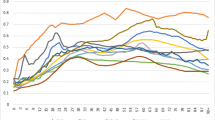Abstract
In this paper, the effects on aggregate consumption of changes in the age distribution of the population are analysed empirically. Economic theories predict that age influences individuals’ saving and consumption behaviour. Despite this, age structure effects are rarely controlled for in empirical consumption functions. Our findings suggest that they should. By analysing Norwegian quarterly time series data, we find that changes in the age distribution of the population have significant and life-cycle-consistent effects on aggregate consumption. Furthermore, controlling for age structure effects stabilises the other parameters of the consumption function and reveals significant real interest rate effects.
Similar content being viewed by others
References
Ando A, Modigliani F (1963) The “Life cycle” hypothesis of saving: aggregate implications and tests. Am Econ Rev 53(1):55–84
Andreou E, Spanos A (2003) Statistical adequacy and the testing of trend versus difference stationarity. Econom Rev 22:217–237
Attfield CLF, Cannon E (2003) The impact of age distribution variables on the long run consumption function. Discussion paper 03/546, University of Bristol
Berg L (1994) Household savings and debts: the experience of the nordic countries. Oxf Rev Econ Policy 10(2):42–53
Bosworth B, Burtless G, Sabelhaus J (1991) The decline in saving: evidence from household survey. Brookings Pap Econ Act 1:183–241
Brodin PA, Nymoen R (1992) Wealth effects and exogeneity: the Norwegian consumption function 1966.1–1989.4. Oxf Bull Econ Stat 54:431–454
Deaton A, Paxson C (2000) Growth and saving among individuals and households. Rev Econ Stat 82
Demery D, Duck NW (2001) Savings age profiles in the UK. Discussion paper 01/518, University of Bristol, UK
Doornik JA (2003) Asymptotic tables for cointegration tests based on the gamma-distribution approach. Nuffield College, University of Oxford
Doornik JA, Hendry DF (1999) Empirical econometric modelling using PcGive, vol 1. Timberlake Consultants, West Wickham
Eitrheim Ø, Jansen ES, Nymoen R (2002) Progress from forecast failure: the Norwegian consumption function. Econom J 5:40–64
Erlandsen S (2003) Age structure effects and consumption in Norway. 1968(3)–1998(4). Working paper 1, Norges Bank
Erlandsen S, Nymoen R (2004) Consumption and population age structure. Memorandum 27, University of Oslo, Department of Economics
Fair RC, Dominguez KM (1991) Effects of the changing U.S. age distribution on macroeconomic equations. Am Econ Rev 81:1276–1294
Halvorsen E (2004) Three essays on household savings in Norway. Ph.D. thesis, University of Oslo
Hansen H, Johansen S (1999) Some tests for parameter constancy in cointegrated VAR models. Econom J 2:306–333
Harbo I, Johansen S, Nielsen B, Rahbek A (1998) Asymptotic inference on cointegrating rank in partial system. J Bus Econ Stat 16:388–399
Hendry DF, Juselius K (2001) Explaining cointegration analysis: part II. Energy J 22(1):75–120
Higgins M (1998) Demography, national saving, and international capital flows. Int Econ Rev 343–369
Horioka CY (1997) A cointegration ananlysis of the impact of the age structure of the population on the household saving rate in Japan. Rev Econ Stat 79:511–516
Jansen ES, Teräsvirta T (1996) Testing parameter constancy and super exogeneity in econometric equations. Oxf Bull Econ Stat 58:735–763
Johansen S (1988) Statistical analysis of cointegration vectors. J Econ Dyn Control 12:231–254
Johansen S (1995) Likelihood-based inference in cointegrated vector autoregressive models. Oxford University Press, Oxford
Leff NH (1969) Dependency rates and savings rates. Am Econ Rev 59:886–896
Lehmussaari O-P (1990) Deregulation and consumption. Savings dynamics in the Nordic countries. IMF Staff Pap 37:71–93
Masson P, Bayoumi T, Samei H (1996) International evidence on the determinants of private saving. Discussion paper series 1368, CEPR
McMillan HM, Baesel JB (1990) The macroeconomic impact of the baby boom generation. J Macroecon 12:167–195
Miles D (1999) Modelling the impact of demographic change upon the economy. Econ J 109:1–36
Modigliani F, Brumberg R (1954) Utility analysis and the consumption function: an interpretation of cross-section data. In: Kurihara K (ed) Post-Keynesian economics. Rutgers University Press, New Brunswick, pp 388–436
Muellbauer J, Murphy A (1990) Is the UK balance of payments sustainable? Econ Policy 11:349–395 (with discussion)
Parker JA (1999) Spendthrift in America? On two decades of decline in the U.S. saving rate. In: Bernanke B, Rotemberg J (eds) NBER macroeconomics annual. MIT, Cambridge, Massachusetts, pp 317–370
Weil DN (1994) The saving of the elderly in micro and macro data. Q J Econ 109:55–81
Author information
Authors and Affiliations
Corresponding author
Additional information
Responsible editor: Junzen Zhang
Rights and permissions
About this article
Cite this article
Erlandsen, S., Nymoen, R. Consumption and population age structure. J Popul Econ 21, 505–520 (2008). https://doi.org/10.1007/s00148-006-0088-5
Received:
Accepted:
Published:
Issue Date:
DOI: https://doi.org/10.1007/s00148-006-0088-5




